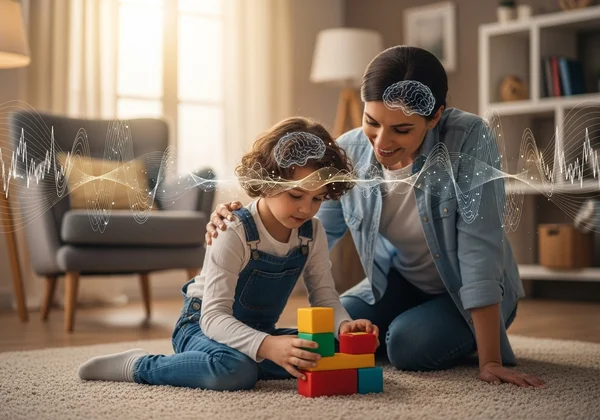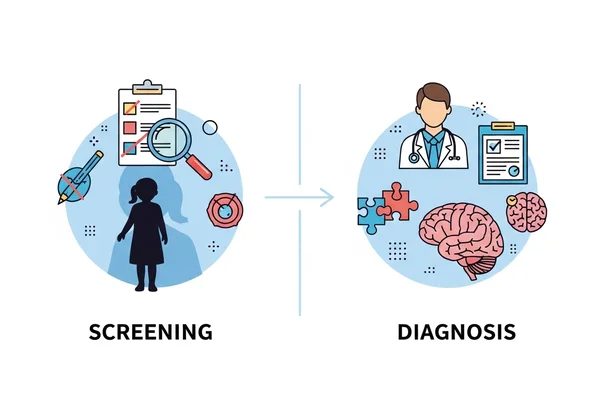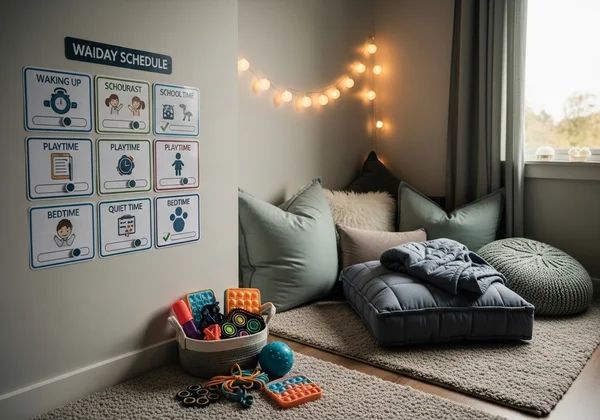Child's RAADS-R Test: A Parent's Guide After Autism Screening
October 30, 2025 | By Elara Vance
Seeing a high score on your child’s RAADS-R test can bring mixed emotions — concern, confusion, but also relief. As parents, it’s important to remember this moment is not the end; it's a starting point. It’s an opportunity to understand your child more deeply and learn how to best support their unique way of experiencing the world. So, what do you do when an autism screening suggests your child might be neurodivergent? This guide offers practical steps and useful advice to help you move forward with confidence. For many parents, an initial screening is the first step, and tools like our free screening tool can provide valuable early insights.
Understanding Your Child's RAADS-R Results
The first step is understanding the results clearly. A score on the RAADS-R (Ritvo Autism and Asperger Diagnostic Scale-Revised) is a collection of data points based on your observations. It is a powerful tool for reflection, but it has limits, especially for younger children. Recognizing what the score means and what it doesn’t will shape every decision that follows.

What a High RAADS-R Score Might Mean for Your Child
A high score on this child autism screening suggests your child may show traits often linked with autism. The test on our site covers four main areas: Social Relatedness, Language, Sensory-Motor, and Circumscribed Interests.
A strong result in these areas indicates your child’s behaviors align with common autistic experiences. Think of it as a signpost, not a destination. For example, intense focus on a specific topic might point to circumscribed interests, while sensitivity to loud noises could reflect sensory-motor differences. This new understanding can shift your view from confusion to compassion.
Screening vs. Diagnosis: Setting Realistic Expectations
This is the most critical point to grasp: a screening test is not a medical diagnosis. Our online test is a useful starting point but not a medical assessment. It highlights possible traits that may need further professional evaluation. However, there are clear RAADS-R test limitations for children, since formal diagnosis requires specialized tools.
A full diagnosis must come from qualified healthcare professionals, such as pediatricians, child psychologists, or neurologists. They combine interviews, observations, and developmental history. Use the RAADS-R score as supporting information, not a definitive label.

Practical Steps After Your Child's Autism Screening
Getting a high autism score can feel overwhelming, but you can turn that concern into supportive actions. The period following an initial screening is a crucial time for observation and connection. By taking small, practical steps, you can better understand your child's needs and strengthen relationship.
Observing and Documenting Traits at Home
Your observations as a parent are invaluable. Begin tracking child's autistic behaviors, strengths, and challenges in a daily journal. Note specific examples such as:
- Social interactions: How do they play with peers? Do they prefer solitary activities? How do they show affection?
- Communication: Note their use of language. Is it advanced for their age in some areas but delayed in others? Do they interpret things literally?
- Sensory sensitivities: Do they react strongly to certain sounds, textures, lights, or tastes? Do they seek out specific sensory inputs, like spinning or deep pressure?
- Routines and interests: How do they handle changes in routine? What are their passions, and how intense is their focus on them?
This detailed record will help professionals understand your child more clearly. It is also a practical way to spot changes over time.

Communicating with Your Child About Their Unique Traits
How you discuss these traits depends on your child’s age, but your message should always reflect acceptance and love. Avoid calling these traits as problems. Instead, focus on celebrating their unique perspective.
You might start by talking to your autistic child about their strengths. For example, "I love how you can focus so deeply on your LEGOs and build such amazing things," or "It’s okay that loud parties are uncomfortable for you; we can find quieter ways to have fun." Positive conversations build confidence and self-esteem.
Navigating the Path to Professional Evaluation
With your observations in hand, the next step is to seek professional guidance. This might be a daunting process, but breaking it down into actionable steps makes it much clearer.
Deciding When a Formal Autism Diagnosis is Right for Your Child
Choosing a formal diagnosis has both benefits and considerations. Understanding the benefits of professional autism diagnosis for children can help you make an informed choice.A professional evaluation can open access to therapies, educational accommodations, and tailored support. It can also help your child understand their identity and feel validated.
However, it's also valid to have concerns about labeling. The key is to focus on what will best support your child's well-being and development. A diagnosis is not a label — it’s a tool for empowerment.
Finding Qualified Autism Specialists for Your Child
Finding the right professional is key to a positive experience. Start by asking your pediatrician for a referral to a specialist in child autism diagnostic services. Look for clinicians who have experience with pediatric neurodevelopmental assessments.
When you contact potential providers, ask about their evaluation process. A thorough assessment should involve multiple sessions, interviews with you, direct observation of your child, and standardized testing. It should be a comprehensive process that looks at the whole child — their strengths as well as their challenges. Taking the first step can be as simple as exploring the initial AI personalized report to gather more detailed insights.
Creating a Supportive Environment for Your Autistic Child
Whether you pursue a formal diagnosis or not, you can begin making changes at home and in your community to create a more supportive environment for your child. The goal is to help your child thrive by accommodating their needs and celebrating their strengths. This journey is about adapting the environment to fit the child, not the other way around.
Everyday Strategies for Parenting an Autistic Child
Small adjustments can make a big difference in the daily life of a neurodivergent child. Effective parenting an autistic child often involves creating predictability and respecting their sensory needs. Consider implementing strategies like:
- Visual schedules: Use pictures or charts to outline the day’s activities. This reduces anxiety by making routines predictable.
- Sensory-friendly spaces: Create a quiet, cozy corner in your home where your child can retreat when they feel overwhelmed.
- Lean into special interests: Embrace your child's passions. They are not just hobbies; they are sources of joy, learning, and self-regulation.
Small changes like these can reduce stress and support development. Over time, these habits build confidence and security.

Connecting with Local and Online Support Communities
You are not alone on this journey. Connecting with other parents can provide emotional support and practical advice. Look for local autism parent groups or explore online forums and social media groups dedicated to neurodiversity.
Furthermore, encourage your child to connect with communities where they feel accepted. Listening to autistic adults can offer valuable perspective. These communities offer a wealth of lived experience and support that complements professional advice. Discovering these resources is a vital part of the process, and it all starts with understanding your child's traits.
Empowering Your Journey: Next Steps for Your Family
A high RAADS-R score is not a verdict—it’s a doorway to understanding. It’s an invitation to learn a new language of support, one that honors your child's unique mind and abilities. Remember to be patient with yourself and your child. Celebrate small victories, seek support when you need it, and lead with love and acceptance.
This journey of discovery is just beginning. To gain even more nuanced insights tailored to your child’s specific situation, consider exploring the AI personalized analysis report available on our site. It can help you connect the dots and empower you with knowledge for the road ahead.
Frequently Asked Questions for Parents After a High RAADS-R Score
How accurate is the RAADS-R test for screening autism in children?
The RAADS-R was originally designed for adults, but its framework is helpful for identifying autistic traits in older children and adolescents with parental input. As a screening tool, its purpose is not to be diagnostically "accurate" but to effectively indicate whether a professional evaluation is warranted. Its accuracy depends heavily on the parent's detailed and honest observations.
At what age can the RAADS-R test be used to screen a child?
While the questions can be adapted by parents for children, the RAADS-R test is most reliable for adolescents and adults who can self-report or whose long-term traits are easily observable. For younger children, specialized developmental screenings administered by a pediatrician or specialist are more appropriate. Our online test is best used as a reflective tool for parents of children old enough to have observable social and behavioral patterns.
Can my child receive an autism diagnosis based solely on a high RAADS-R score?
No, absolutely not. This is the most important takeaway. A high score on our test or any other online screening tool cannot and should not be used as a diagnosis. It is a non-medical, educational tool that suggests further exploration is a good idea. A formal diagnosis can only be given by a qualified professional after a comprehensive clinical evaluation. If you have concerns, use the test results as a starting point for a conversation with a doctor or to start your assessment journey.